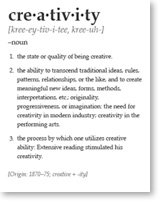I have always been impressed by clear and simple displays of creativity in the arts and sciences. There are those who bring out something new and important in such a natural way. As a neurologist, I have a natural curiosity about what happens differently in our brain when we create. Researchers have spoken about the process of creative thinking as the direct opposite of analytical thinking. Analysis requires very focused attention, whereas creativity is a synthetic process, letting an idea come forth in its wholeness. The process of analysis can be taught, and in fact it is the focus of much of our scientific education. But we don’t talk about teaching creativity; instead we talk about nurturing it, about setting up the right conditions for a creative thought, whether it is expressed as an auditory, visual, or a theoretical breakthrough.
 In the brain, these breakthrough ‘aha’ moments of creativity have been associated with an increase in power of alpha brainwave activity, particularly towards the back of the brain, and an increase in synchronous alpha activity between the two hemispheres. There is a real similarity between the brain activity we measure during creative moments and during moments of transcending thought during the Transcendental Meditation technique. This should come as no surprise, because the effortless activity of transcending is the opposite of the narrowly focused activity of analysis. It is simply allowing the mind to reach its ground state, where we can experience thought at its creation.
In the brain, these breakthrough ‘aha’ moments of creativity have been associated with an increase in power of alpha brainwave activity, particularly towards the back of the brain, and an increase in synchronous alpha activity between the two hemispheres. There is a real similarity between the brain activity we measure during creative moments and during moments of transcending thought during the Transcendental Meditation technique. This should come as no surprise, because the effortless activity of transcending is the opposite of the narrowly focused activity of analysis. It is simply allowing the mind to reach its ground state, where we can experience thought at its creation.
 Some people are more prolific with their creative endeavors than others, and many talk about setting up their environment in a particular way to allow for creative juices to flow. What we are nurturing is a direct, unimpeded channel between the conscious mind and the unbounded ground state of the mind, at once infinitely silent, and the source of all creative expression. Regular practice of the Transcendental Meditation technique removes the obstacles that prevent the full expression from that infinite creative reservoir. It is no wonder that artists and scientists alike find that the practice of TM brings new vitality to their work, and that communities of meditators have become cradles of creativity.
Some people are more prolific with their creative endeavors than others, and many talk about setting up their environment in a particular way to allow for creative juices to flow. What we are nurturing is a direct, unimpeded channel between the conscious mind and the unbounded ground state of the mind, at once infinitely silent, and the source of all creative expression. Regular practice of the Transcendental Meditation technique removes the obstacles that prevent the full expression from that infinite creative reservoir. It is no wonder that artists and scientists alike find that the practice of TM brings new vitality to their work, and that communities of meditators have become cradles of creativity.
You may also like to read: A neurologist’s first blog post



